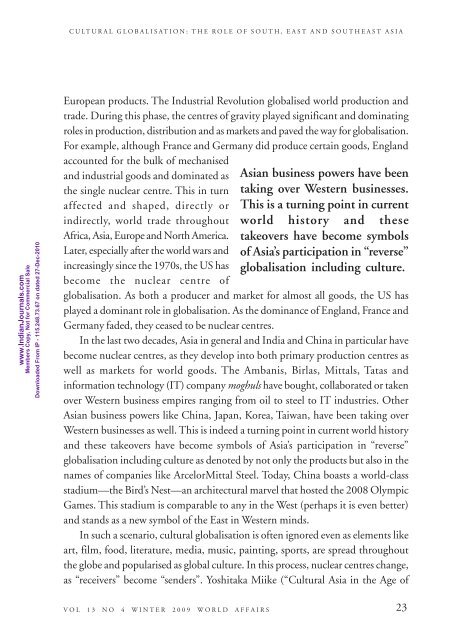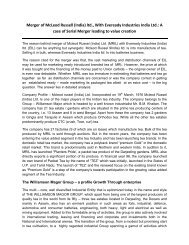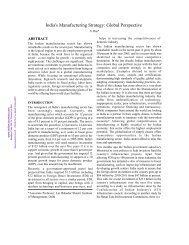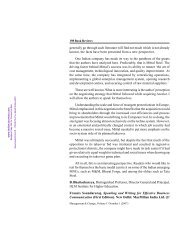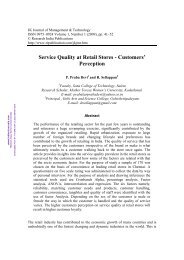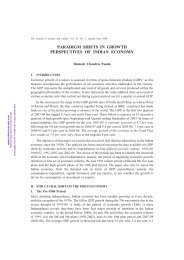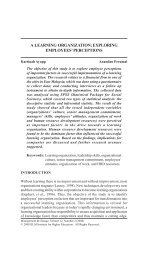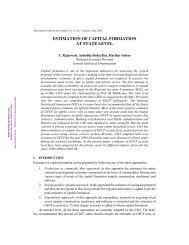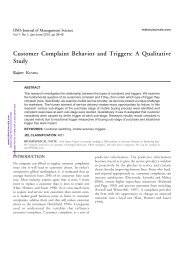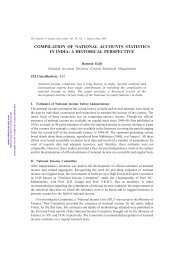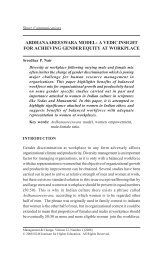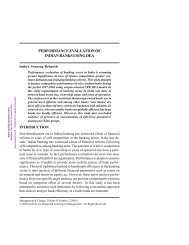Cultural Globalisation - Mimts.org
Cultural Globalisation - Mimts.org
Cultural Globalisation - Mimts.org
Create successful ePaper yourself
Turn your PDF publications into a flip-book with our unique Google optimized e-Paper software.
CULTURAL GLOBALISATION: THE ROLE OF SOUTH, EAST AND SOUTHEAST ASIA<br />
www.IndianJournals.com<br />
Members Copy, Not for Commercial Sale<br />
Downloaded From IP - 115.248.73.67 on dated 27-Dec-2010<br />
European products. The Industrial Revolution globalised world production and<br />
trade. During this phase, the centres of gravity played significant and dominating<br />
roles in production, distribution and as markets and paved the way for globalisation.<br />
For example, although France and Germany did produce certain goods, England<br />
accounted for the bulk of mechanised<br />
and industrial goods and dominated as<br />
the single nuclear centre. This in turn<br />
affected and shaped, directly or<br />
indirectly, world trade throughout<br />
Africa, Asia, Europe and North America.<br />
Later, especially after the world wars and<br />
increasingly since the 1970s, the US has<br />
become the nuclear centre of<br />
Asian business powers have been<br />
taking over Western businesses.<br />
This is a turning point in current<br />
world history and these<br />
takeovers have become symbols<br />
of Asia’s participation in “reverse”<br />
globalisation including culture.<br />
globalisation. As both a producer and market for almost all goods, the US has<br />
played a dominant role in globalisation. As the dominance of England, France and<br />
Germany faded, they ceased to be nuclear centres.<br />
In the last two decades, Asia in general and India and China in particular have<br />
become nuclear centres, as they develop into both primary production centres as<br />
well as markets for world goods. The Ambanis, Birlas, Mittals, Tatas and<br />
information technology (IT) company moghuls have bought, collaborated or taken<br />
over Western business empires ranging from oil to steel to IT industries. Other<br />
Asian business powers like China, Japan, Korea, Taiwan, have been taking over<br />
Western businesses as well. This is indeed a turning point in current world history<br />
and these takeovers have become symbols of Asia’s participation in “reverse”<br />
globalisation including culture as denoted by not only the products but also in the<br />
names of companies like ArcelorMittal Steel. Today, China boasts a world-class<br />
stadium—the Bird’s Nest—an architectural marvel that hosted the 2008 Olympic<br />
Games. This stadium is comparable to any in the West (perhaps it is even better)<br />
and stands as a new symbol of the East in Western minds.<br />
In such a scenario, cultural globalisation is often ignored even as elements like<br />
art, film, food, literature, media, music, painting, sports, are spread throughout<br />
the globe and popularised as global culture. In this process, nuclear centres change,<br />
as “receivers” become “senders”. Yoshitaka Miike (“<strong>Cultural</strong> Asia in the Age of<br />
VOL 13 NO 4 WINTER 2009 WORLD AFFAIRS 23


